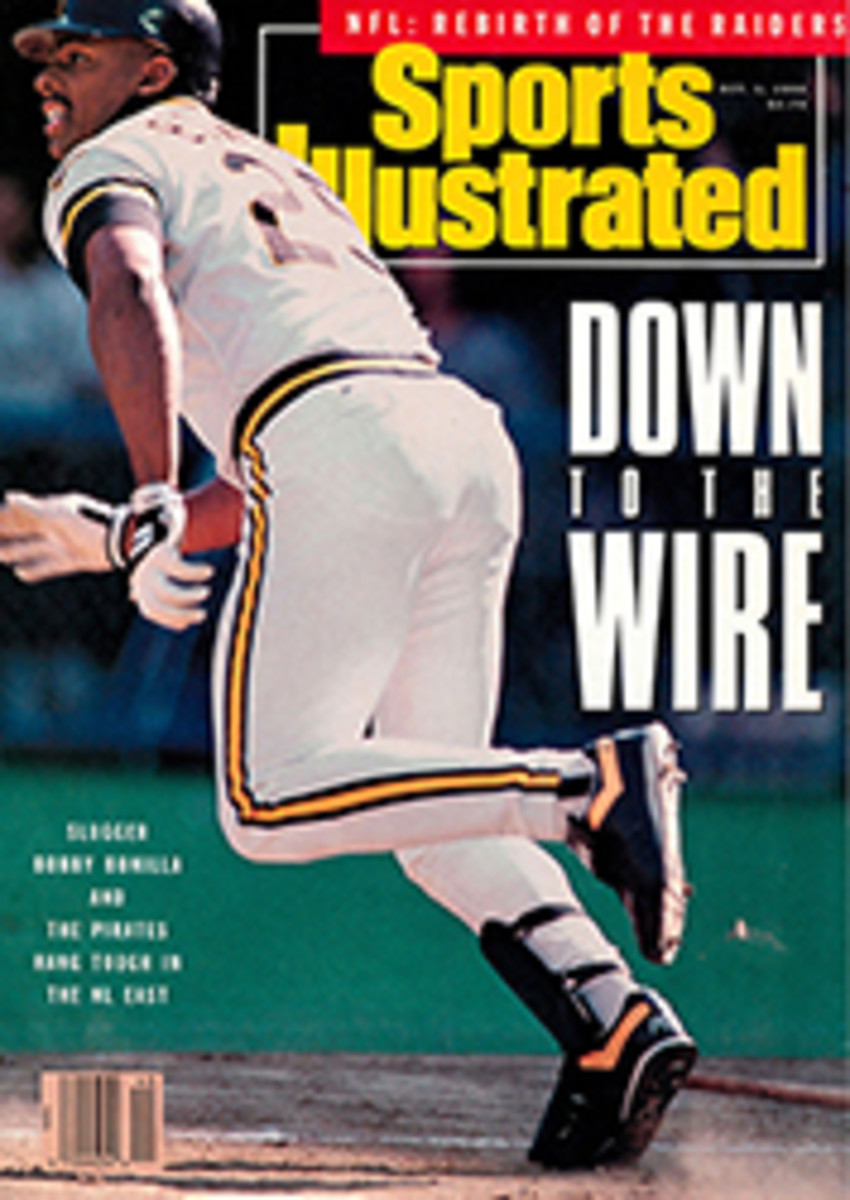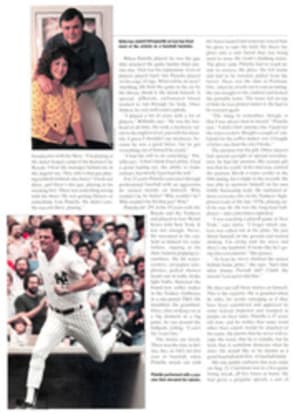
HEAVY METAL'S MAN OF STEEL
Offstage and out of his spandex knickers, Bruce Dickinson doesn't play the shrill and pampered prima donna. In fact, there isn't much about the Air Raid Siren, as the leather-lunged lead singer of the British heavy-metal group Iron Maiden is nicknamed, that fits the image of a rock 'n' roll animal.
Dickinson, 32, has a degree in history from the University of London. He's a published novelist, albeit of a rather bawdy talc, The Adventures of Lord Iffy Boatrace, which a few members of Parliament would like to see banned. He's working on a rock opera about Italian violinist and composer Niccoló¬ß Paganini. He had been going with the same woman for several years, before marrying her in May. He doesn't use drugs, and he's sharply critical of metalists who do. "There are a lot of bands using self-abuse as a marketing gimmick," he says. "Metal music has been ambushed by a fashionable West Coast wasted look—you know, the red bandanna and the heroin needle sticking out of your arm. I think that's disgusting."
But the thing about Dickinson that least conforms to the M.O. of the metal magnate is his passion for, of all sports, fencing. Dirt-biking, bungee-jumping—those seem like they might be a rocker's preferred recreation. But fencing? Incongruous as it may seem, the man who wrote and recorded Bring Your Daughter to the Slaughter for the Nightmare on Elm Street 5 sound track was also the seventh-best foil fencer in Great Britain during the 1988-89 fencing season.
That ranking placed Dickinson just below the top tier of British fencing, a remarkable achievement inasmuch as he didn't really begin concentrating on the sport until he was 25, after having taken it up when he was a teenager. What's more, because Dickinson is often in a recording studio or out on year-long concert tours, usually far from a reputable salle d'armes, he can't spend nearly as much time training as do those in fencing's upper echelon. But what makes Dickinson's climb through the ranks still more impressive is that he accomplished it after he switched his fencing hand from his right to his left in 1986.
"I find that fencing and training give me more stamina and help me deal with the craziness of being on the road so much," he says.
Dickinson discovered the sport's rigors at the Oundle School, a boarding school in Northhamptonshire. Though a solitary sort as a kid growing up in Sheffield, he played some cricket and enjoyed go-kart racing. At Oundle he was becoming interested in the three R's—rowing, rugby and running—when, fittingly, a metalwork teacher gave him his first fencing lesson. "I'm a ham," Dickinson says. "I was immediately attracted to fencing because it seemed like a romantic, melodramatic form of combat." At 15 he won the school fencing championship and became team captain. At 17, however, he was expelled from school for' what he describes as "nonsporting reasons."
A training stint with the British equivalent of the army reserve convinced Dickinson that school wasn't so bad after all. In 1977, he enrolled at the University of London's Queen Mary College and fenced on occasion, although singing and studying took priority. After earning a degree, he sang with a band called Samson until Iron Maiden invited him to join up in 1981.
Dickinson's robust tenor and animated stage presence added a theatrical dimension to Maiden's crunch-and-squeal guitar sound. His first album with the band, The Number of the Beast, went to the top of the British charts and helped Maiden break into the U.S. market. But success in the music business, especially the metallic end, which gets minimal air play, is spelled T-O-U-R. To promote an album, Iron Maiden typically spends a year or more on the road, with concerts on more than half the days. Ultimately, it was the toll of touring that persuaded Dickinson to pick up his weapon again.
"Life on the road can get a little one-dimensional," he says. "I wanted to get back into fencing to do something outside rock 'n' roll. I didn't want to reach 40 and have to say all I'd done was look out the window of a tour bus and get drunk."
He trained sporadically and competed in regional tournaments in Britain for several years before making a serious commitment to the sport. Through the summer of 1985, Dickinson studied five days a week under British Olympic foil coach Ziemak Wojciechowski. But Dickinson's hard work wasn't doing his fencing much good.
He might have remained an earnest but middling fencer had he not stumbled on the fact that he was using the wrong hand. "My father found out he was lefthanded while shooting in the army," says Dickinson, who also figured out through firearms that he wasn't entirely righthanded. One day on the road, the boys in the band were fooling around with a target pistol and someone pointed out to Dickinson that he was sighting with his left eye. He read up on eye-hand coordination and left-right brain functions and decided to convert himself into a southpaw foilsman.
He worked on the switch while dividing his time between training sessions on the isle of Jersey and recording sessions in Amsterdam. "Basically, I had to learn how to fence all over again," says Dickinson. "It was strange at first. Everything was so much more natural, I thought I was doing something wrong. My coordination and timing had also improved considerably, though I still had problems with my legs, which had been conditioned to righthanded fencing."
By the summer of 1986 Dickinson was about as good lefthanded as he had ever been righthanded, making it to the round of 16 in tournaments in Holland and Britain. When the band toured the U.S. later that year, he called on his network of contacts in the fencing community to find out where he could pick up a match or a lesson. Sometimes he finished fencing only hours before showtime. One tournament at the University of Southern California concluded 50 minutes before the band was scheduled to perform in Long Beach.
Many of the acquaintances Dickinson has made through fencing have only a vague knowledge of his other life. Nathaniel Cohen, a 26-year-old Yale graduate ranked 16th in foil in the U.S., remembers meeting Dickinson and fencing with him at the New York Fencers Club a few years ago. Cohen's impression was of "a nice, unassuming English guy with long hair. The only thing that tipped me off was this group of 14-year-old girls hanging around."
In 1987, after recording another album in West Germany, he stayed on and worked out at the Olympic training center in Bonn for six months. His ranking jumped accordingly; by the end of the 1987-88 season he was 18th in Britain.
After yet another world tour, Dickinson returned to England and immersed himself in competition for seven months. By the end of the '88-89 season he was ranked seventh. His team, Hemel Hempstead, finished first in the national team championships. But last season, '89-90, though the team came in fourth, Dickinson, who had had little time to train or to compete, saw his ranking slip back to 35th.
"Bruce has an explosive offense and is very clever on defense," says George Kolombatovich, the coach at Columbia University, a perennial NCAA fencing power. "But that trickiness can also be his greatest weakness."
"Well, yeah, sometimes I get a little too creative," Dickinson says. "You don't get points for style."
Eric Rosenberg, formerly ranked sixth in the U.S., and vice-president of the New York Fencers Club, agrees that Dickinson's fencing has room for improvement. "His preparation could be better," he says, referring not to Dickinson's combat readiness but to the suppleness and fluidity with which a good fencer initiates his attack. Dickinson, however, recently had the opportunity of fencing Rosenberg and beat him in two of three bouts. "Bruce's preparation is definitely coming along," Rosenberg conceded after his defeat.
Dickinson's best years may still be ahead of him. While age may be slowing his reflexes, some fencers peak in their mid-to late 30's. In a game in which mental toughness and tactical savvy are as critical as quickness, experience can still triumph over raw athleticism.
So despite having many other irons in the fire—a fencing-equipment import business; a solo album, Tattooed Millionaire, as well as a brand-new one from Iron Maiden, No Prayer for the Dying, in release; and a baby due in several weeks—the nimble-footed Air Raid Siren hopes to hit a few more high notes behind both the blade and the microphone.
PHOTO
SIPA PRESS
Dickinson began fencing because it seemed a "romantic form of combat."
PHOTO
DAVE HOGAN/LGI
Performing for Iron Maiden seems to be a form of combat for Dickinson, too.
Jack Mason is a writer for Time Inc. Magazines' in-house newsletter.

